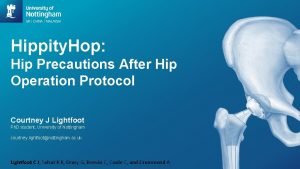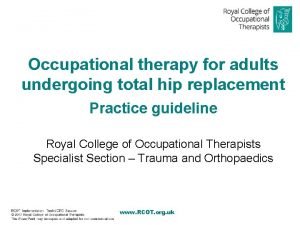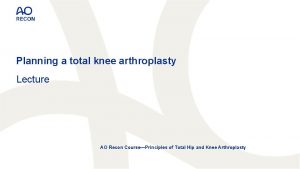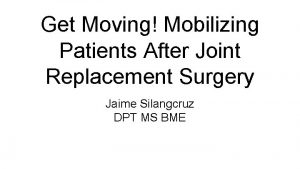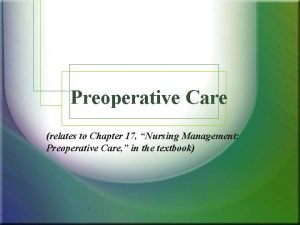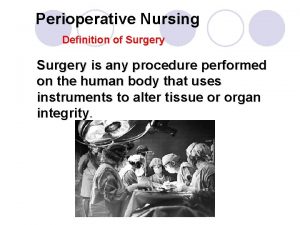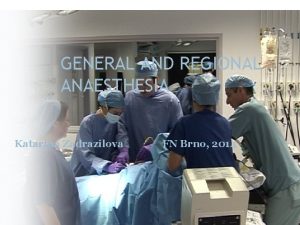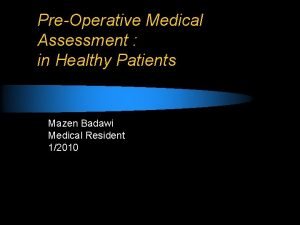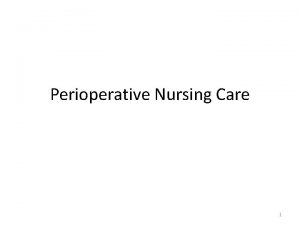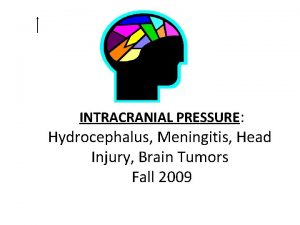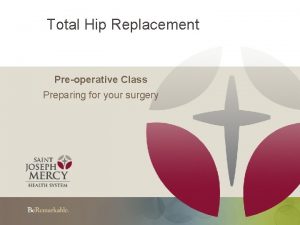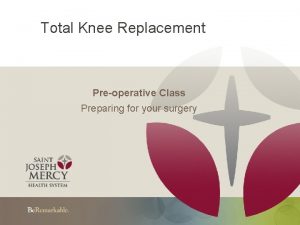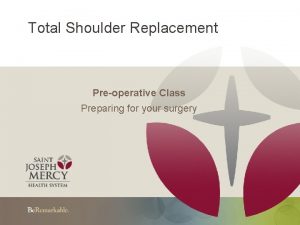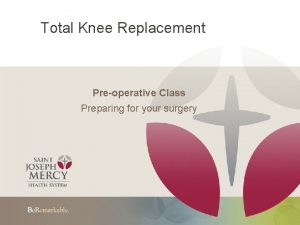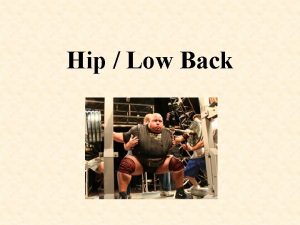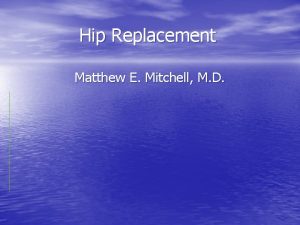Total Hip Replacement Preoperative Class Preparing for your






















































- Slides: 54

Total Hip Replacement Pre-operative Class Preparing for your surgery

Virtual Class Reminders Microphones are automatically muted • Please type your questions in the chat box and I will answer them at the end of the class • You can find the class packet with handouts, the Knee Book, these slides and a class video on our website stjoeshealth. org/ortho-help • © 2015 2

Class Objectives The purpose of this presentation is to: Help you to feel more comfortable about your upcoming hospitalization To let you know what you can do to help in your own recovery 3

Michigan Arthroplasty Registry Collaborative Quality Initiative - MARCQI • Your surgeon participates in MARCQI which tracks patients for quality improvement purposes • Michigan hospitals and orthopedic surgeons working together to reduce complications and improve your recovery • You will be asked to complete surveys before and after surgery at multiple intervals-90 day, 1, 2, 5, and 10 year intervals. • HOOS Survey-this can be completed on paper or via e-mail © 2015 4

Twistle © 2015 5

Twistle • • • A safe/secure app for your smart phone or tablet Your healthcare team will send you reminders, education, messages and health surveys You will be sent an invitation on your smart phone to participate, you can then download the app Messages start 35 days before surgery and continue for 30 days after you get home Twistle is not for use in an emergency or urgent situation © 2015 6

Twistle If you are interested in signing up for Twistle please send me an email with the following information • Your Name • Birthdate • Cell phone number • Surgeon • Surgery Date and if you are having a hip or knee replacement Molly. Sieffert@stjoeshealth. org © 2015 7

Preparing for your surgery 8

Selecting Your Joint Coach What? A coach is a person who can help support you in your recovery at the hospital and at home. Who? A coach can be anyone: a spouse, a family member, a friend or a companion. Why? A coach is someone that will help you stay motivated and succeed. We all need encouragement at times to help us along the way. Your coach can provide this encouragement for your just by being present and participating in your therapy both at the hospital and after your discharge. Expectations? Attend at least one physical therapy session in the hospital. Assist with your needs after discharge. © 2015 9

Tips for Preparing your Home You and your family must consider these tips before your surgery to help make your home as safe and comfortable as possible for your return after surgery: • Check every room for tripping hazards. Remove throw rugs and secure cords • Arrange furniture to have unobstructed pathways while using walker • Move items in lower drawers to height to eliminate excessive bending or reaching • Plan on using a cordless phone or cell phone that can be tucked away inside a pocket • Make sure stairs have handrails that are securely fastened to walls • In homes with steep long stairs you may need a bed, portable toilet on first level • If you have pets you may want to arrange boarding them first few days you are home • A chair with a firm back and arm rests is recommended, NO chairs on wheels • Prepare or purchase meals ahead of time to minimize cooking after surgery • Install night lights in bathrooms, bedrooms, and hallways • Avoid yard work for 10 days prior to surgery. Protect your operative site from injury • Do laundry ahead of time • Get a non-slip bathmat • Put clean linens on your bed © 2015 10

What to Bring with You • If you have Advanced Directives please bring them with you • Personal care items • Robe • Good fitting slippers/shoes – your leg/foot will be swollen following surgery so make sure they are not tight before your surgery • Clothes - Loose shorts, T-shirt/top. We want you to get dressed • Please do not bring your own pillow • If you use a CPAP machine at home bring it with you, we have distilled water in the hospital for you to use • Driver’s license, Insurance Cards and a check or credit card to pay for home medical equipment © 2015 11

Enhanced Recovery Program Ensure Pre-Surgery clear nutrition drink is a carbohydrate rich beverage with added supplements that you will drink in the car on the way to the hospital on the day of your surgery Use of Ensure Pre-Surgery Improves • Comfort • Hydration • Hunger • Thirst © 2015 12

Enhanced Recovery Program Ensure Pre-Surgery is available for purchase at the pharmacy in the Reichert Health Buildingapprox. $4 for 1 bottle • You will need to purchase 1 bottle • You need to ask for the Ensure Pre-Surgery at the pharmacy counter • This is not for use by Type 1 diabetic patients • © 2015 13

Reducing Risks and Complications • Stay active – Exercises for before your surgery are in your book and will be explained further by PT • Healthy diet - Before your surgery, avoid foods that increase inflammation in your body. Those foods include sugar and white flour; saturated fats from red and organ meat; trans fats from commercially baked cookies, cakes and pastries; and alcohol. Aim for fresh foods, including fresh fruits, vegetables and nuts • Manage diabetes – see your PCP if needed • Reduce, eliminate tobacco. Smoking increases your risk of developing wound infection so we encourage you to try to stop before your surgery 1 -800 -Quit-Now can offer free advice • Reduce, eliminate alcohol. Hazardous alcohol use (3 or more drinks per day) can increase your risk of postoperative infections, cardiopulmonary complications and bleeding risk © 2015 14

Prevent Surgical Site Infection • • Dental work – must be completed 1 week prior to surgery and delayed for 3 months after your surgery Shaving – do not shave your legs or use any hair removal products near the surgical site 5 days prior to surgery Hand washing – Good hand hygiene is essential. Encourage your family and friends to utilize an antibacterial cleanser and to always wash their hands to prevent spread of infection Preoperative nasal swab Use the wipes that you were given in class or at your physical on the evening before surgery. Read the instructions very carefully. Do not use them on your face or private area. In pre-op you will receive intranasal treatment to help prevent postoperative infection Optifoam AG+ Dressing © 2015 15

Surgery and Postoperative Recovery © 2015 16

Day of Surgery • Meet anesthesiologist to discuss options for anesthesia • Only 2 members of your family are allowed in pre op with you. All family members can wait in the surgical waiting room during your surgery. It is unlikely you will be able to see your family member until you leave recovery and arrive on the unit • Surgery will take between 1 -2 hours and the patient will remain in the recovery room for 1 -2 hours so from the beginning of the surgery to arriving on the unit may be up to 4 hours 17

Recovery Room • You will wake up after your surgery in the recovery room • Your nurse will ask how your pain is on the pain scale of 0 -10, 0 no pain, 10 worst pain imagined • When you wake up you may have a urinary catheter to drain urine, a dressing over your incision, sequential compression devices (SCD’s) on your legs, oxygen in your nose and IV fluids connected to an IV in your arm © 2015 18

Sequential Compression Devices (SCD’s) A Sequential Compression Device (SCD) is equipment that can assist in prevention of deep vein thrombosis (DVT). It improves blood flow in the legs. SCD’s are shaped like “sleeves” that wrap around the legs and inflate with air one at a time. This imitates walking and helps prevent blood clots. You should wear your SCD’s any time you are in bed or sitting in a chair. © 2015 19

Anticoagulation Therapy Your surgeon will prescribe an anticoagulant to help prevent blood clots • There are many different medications we use for this, the anticoagulation will begin to be administered on post op day one and will continue as prescribed by your surgeon • You will receive information and instructions on how to take this medication from your nurse before you are discharged home. It is important you take this medication as instructed • © 2015 20

When you arrive on the Short Stay/Ortho Unit You will start to eat/drink jello, crackers, water, ginger ale and progress to your regular diet • We will show you how to use an incentive spirometer and encourage you to use it 10/hour • You will begin your rehabilitation today, either with physical therapy or nursing staff helping you to the side of the bed, walking around your room and/or sitting in the recliner • Your nursing staff will have to check on you frequently the first night • © 2015 21

Incentive Spirometer Use your incentive spirometer throughout your hospital stay. Please take it home with you after your discharge and continue to use it for 2 weeks. © 2015 • Sit in an upright position • Inhale slowly and deeply to raise the indictor • When you can’t breathe in any longer take out mouthpiece and hold breath for 3 -5 seconds • Exhale and repeat 10 times an hour 22

Pain Management • • Your caregiver will do everything they can to get you comfortable enough to participate in your recovery Caregivers will often ask you to rate your pain level on a scale of 0 -10 Our goal is always to keep your pain at a level so you can participate in your rehabilitation Your pain will be managed with different medications including IV medications and oral medications. Some of these medication are scheduled and given at set times and others are given as needed to help control your pain © 2015 23

Cooling Therapy – Compression Therapy Service 517 -333 -3820 The gel packs are vacuum packed so that the gel stays evenly distributed and pliable at standard freezer temperatures Each wrap features elastic straps that provide static compression while holding the gel packs firmly in place The gel packs are available for purchase after your surgery. You can use them after your surgery both in the hospital and when you get home.

After your Surgery • Your nurse will continue to assess your pain level and work on a plan with you to ensure it is controlled using scheduled Tylenol and opioid pain medication • A side effect of the pain medication is constipation so you will also be started on a bowel management program • Physical Therapy will work with you, helping you regain your strength. As your recovery progresses, you will get up for meals and go to the bathroom with help from our team. The physical therapy team will work with you to ensure a safe discharge home • Our discharge planners will meet with you to discuss your discharge and any equipment needs you may have © 2015 25

Discharge • • • Most people are ready to go home after 1 night in the hospital We want you to go home after your surgery-not rehab Patients recover better in their own home environment Please make sure you arrange to have someone available to drive you home Home physical therapy will be provided if your care team thinks it is necessary to provide additional assistance with physical therapy and your mobility Discharge instructions will be given to you by your nurse and prescriptions given to you which can be filled in our pharmacy, just ask your nurse how to do this © 2015 26

Possible complications following surgery • • Blood clots – follow your surgeons instructions carefully to minimize this potential risk. Make sure you take your anticoagulation medication as instructed by nursing staff and continue doing your ankle exercises Infection – follow instructions given at discharge to prevent infection. Do not remove your dressing until day 7 after your surgery. If the dressing come off, wash your incision with soap and water and pat dry. Leave open to air. Do not use any creams or lotions on your incision Constipation – Your pain medication can make you constipated. Make sure you take laxatives following your discharge and eat a diet high in fiber and drink lots of water Pain - Make sure you take your pain medication as instructed. Elevate your leg higher than your heart. Your leg will swell and this can add to your discomfort © 2015 27

Post-Operative Guide It is normal for your leg to be swollen and the incision to be warm and swollen with red edges. IF YOUR LEG IS SWOLLEN: 1. Elevate your leg: Lie down 4 x/day for 20 -30 minutes and position your leg above your heart. 2. Ice your leg: Apply an ice pack or cold machine throughout the day (20 minutes on, 20 minutes off). Make sure you have something between your skin and the ice, unless using the prescribed ice machine. 3. If swelling does not improve in 24 hours, call your surgeon’s office. IF YOU ARE HAVING PAIN: 1. Take pain medications as directed by your surgeon. 2. Elevate and ice your leg as instructed above. 3. Please refer to your Total Joint Patient Guide pages 22 and 26. 4. If pain does not improve in 24 hours, call your surgeon’s office. 1. Take an over-the-counter stool softener and laxative each day you are taking pain medication. 5. If no bowel movement by the 3 rd day after surgery call your surgeon’s office. IF YOU ARE 2. Eat a high fiber diet and drink plenty of water. HAVING 3. Walk as tolerated. CONSTIPATION: 4. Please refer to your Total Joint Patient Guide page 22. © 2015 28

Surgeons Office Phone Numbers Please call your surgeon’s office for any postoperative concerns Office Numbers • Dr’s Masini, Schultz, Denzin, Telfer, Schueller, Chrissos, Mc. Glaston 734 712 0655 • Dr’s Young, Hakim 734 572 4500 • Dr. Anderson 810 494 6881 © 2015 29

Questions? If you have any questions about anything you have heard today, or have any concerns please do not hesitate to contact me Molly-Orthopedic Nurse Navigator 734 -712 -2392 You can leave a message and I will return your call as soon as possible If you have urgent questions please call your orthopedic surgeons office © 2015 30

Physical Therapy © 2015 31

Pretend you just boarded a plane for California • What is the health risk of taking a long flight? • Why? • What can you do about it? • • What is a health risk after your surgery? What can you do about it? © 2015 32

• Please stand up! • Make it a habit to interrupt your sitting every 1 -2 hours—esp. when flying and after a surgery • Now stay standing…. . © 2015 33

Pre-op Exercises • Rise up on your toes 5 times • • Squat down as if to sit in your chair, but don’t go all the way down, stand back up • • Keep your head up and your back straight Standing hip abduction--Raise ‘surgical leg’ slowly out to side and hold for a count of 1 -2 © 2015 34

Pre-Op Exercises Click on the image to view the video or click here © 2015 35

Pre-op Exercises While holding on to a table/chair in front of you … • Pelvic stability--Stand on your ‘surgical leg’ and raise your other leg out to the side • - Keep your pelvis level! • • - Don’t lean to the side! Excellent exercise to strengthen the hip of the standing leg! Chair push-ups - Use mostly your arms © 2015 36

Pre-op Exercises See “Pre-op Exercise” pp. 11 & 12 of your patient guide booklet • Start with 5 reps, increase to 15 as able • We’ve targeted functional exercises • We also target your hip muscles • • Straight leg raise, bridging • Do these exercises on a bed, no need to get on the floor! © 2015 37

Exercise Log • • • Look at the Hip Exercise Log pp. 13 & 14 - Write in “ 5 x” under ‘Standing Ex’ and “chair push-ups” for today (Tues/Wed) Starting tomorrow, do them twice/day Increase reps every day as you are able • Try to get …. “Strong for Surgery” © 2015 38

Pre- op Exercises Word of Caution: • Don’t hold your breath • Don’t strain or aggravate anything • Do you have a heart condition, other concerns? • • you may want to check with your MD about exercise Use the Exercise Log pp 13 -14 to track your progress © 2015 39

Activity/Walking Log Any pre-op exercise or activity can help your body to be more resilient • That will help reduce your chances of complications • It helps release the “feel good” endorphins • • • Helps you feel better Improves your mood © 2015 40

Activity/Walking Log Walking is hard to beat • • • No special equipment, no gym fees Convenient Do short walks now, bump it up after surgery We’ll give you a pedometer to help you get started! Use the Activity/walking log to keep track • • Just write down your steps every day Stationary bike, swim exercise, yoga, etc. are all good Housework and yardwork count! © 2015 41

What activities do you enjoy? Start setting goals © 2015 42

Hip Guidelines • After surgery you will have some temporary limitations; your surgeon’s office can give you specifics • Nursing and PT will be providing individual instructions on your specific limitations after your surgery © 2015 43

Physical Therapy in the Hospital PT will see you. . . • • Day of surgery • Post-op Day 1 • Once or twice as needed Therapy will include: • • Home Exercise Instruction • Walking • Practice stairs • Family instruction © 2015 44

Post – op Walking • • • Walkers - Use either standard or front-wheeled walker - Avoid 4 -wheeled walkers (ok to use later) Crutches Weight-bearing as tolerated Gait: step first with your surgical leg © 2015 45

Stairs Does a walker fit on your entry steps? This is a very good option! You will lead with the stronger leg going up and the weaker leg going down © 2015 46

1 rail and 1 crutch works well! • If your walker does not fit on each entry step we strongly recommend you have a railing installed • We will practice stairs in the hospital • © 2015 Most people can manage stairs inside the home – assuming you have a railing 47

Home Exercise Program • We will start you with ‘circulation exercises’ • Your PT will instruct you in your home exercises • • • Don’t start any exercises until we ask you to Exercises and household walking will be your rehab for the first several weeks • gradually progress walking and activity • progress to using cane in your opposite hand You may request home PT the first 2 weeks © 2015 48

Outpatient PT You can start outpatient PT after several weeks (you will need a prescription from your surgeon) • Outpatient PT will: • • • help you get a stronger, safer, more flexible hip • gait training You can go to Probility (St. Joe’s) or a place of your choice © 2015 49

Other Online Resources stjoeshealth. org/ortho-help • • Pre-op exercises Post-op exercise video Power. Point slides of this class presentation (all in PDF format, so you can print them Total Hip Book Class Handouts Discharge instruction Power. Point video © 2015 50

Discharge Planning We recommend you have someone stay with you for several days, up to a week • • It does not need to be 24/7 Don’t turn down offers for help! • • Help with meals is particularly helpful © 2015 51

Equipment Front-wheeled Walker • Single crutch or cane – for stairs with a rail • Raised toilet seat – hint: try getting off your toilet without using your surgical leg • Reacher – very helpful, you may want to get one ahead of time • © 2015 52

Summary 1. 2. 3. 4. 5. 6. 7. Pre-op exercises Log your steps/day or some other activity Set an activity goal—we’ll help you get there! Get a railing for your entry steps Visit our website Arrange for help after your surgery Plan your equipment needs © 2015 53

Enjoy your new hip! Your preparation and hard work will pay off You’ll be very glad you had the surgery We wish you well! 54
 Hip hop hip to the hippity
Hip hop hip to the hippity Hip hop hip to the hippity
Hip hop hip to the hippity Occupational therapy hip replacement interventions
Occupational therapy hip replacement interventions Cappagh hospital hip replacement
Cappagh hospital hip replacement Combustion reaction
Combustion reaction Aorecon
Aorecon Knee replacement surgery cost
Knee replacement surgery cost Chapter 1 preparing your path to success
Chapter 1 preparing your path to success Imagine that you are preparing a project with your friend
Imagine that you are preparing a project with your friend Cataracts nursing interventions
Cataracts nursing interventions Nursing management preoperative care
Nursing management preoperative care Three phases of perioperative nursing
Three phases of perioperative nursing Perioperative nurse definition
Perioperative nurse definition Preoperative care definition
Preoperative care definition Preoperative care ppt
Preoperative care ppt Nursing assessment for glaucoma
Nursing assessment for glaucoma Preoperative medical evaluation of the healthy patient
Preoperative medical evaluation of the healthy patient Pre operative care
Pre operative care Cushing reflex
Cushing reflex Activo promedio
Activo promedio Total revenues minus total costs equals
Total revenues minus total costs equals Total revenues minus total costs equals
Total revenues minus total costs equals Total revenues minus total costs equals
Total revenues minus total costs equals Total revenue minus total expenses
Total revenue minus total expenses Give us your hungry your tired your poor
Give us your hungry your tired your poor Formuö
Formuö Typiska drag för en novell
Typiska drag för en novell Tack för att ni lyssnade bild
Tack för att ni lyssnade bild Ekologiskt fotavtryck
Ekologiskt fotavtryck Varför kallas perioden 1918-1939 för mellankrigstiden
Varför kallas perioden 1918-1939 för mellankrigstiden En lathund för arbete med kontinuitetshantering
En lathund för arbete med kontinuitetshantering Underlag för särskild löneskatt på pensionskostnader
Underlag för särskild löneskatt på pensionskostnader Tidböcker
Tidböcker A gastrica
A gastrica Förklara densitet för barn
Förklara densitet för barn Datorkunskap för nybörjare
Datorkunskap för nybörjare Boverket ka
Boverket ka Hur skriver man en tes
Hur skriver man en tes För och nackdelar med firo
För och nackdelar med firo Nyckelkompetenser för livslångt lärande
Nyckelkompetenser för livslångt lärande Påbyggnader för flakfordon
Påbyggnader för flakfordon Arkimedes princip formel
Arkimedes princip formel Offentlig förvaltning
Offentlig förvaltning Bo bergman jag fryser om dina händer
Bo bergman jag fryser om dina händer Presentera för publik crossboss
Presentera för publik crossboss Jiddisch
Jiddisch Bat mitza
Bat mitza Klassificeringsstruktur för kommunala verksamheter
Klassificeringsstruktur för kommunala verksamheter Mjälthilus
Mjälthilus Claes martinsson
Claes martinsson Cks
Cks Lågenergihus nyproduktion
Lågenergihus nyproduktion Mat för idrottare
Mat för idrottare Verktyg för automatisering av utbetalningar
Verktyg för automatisering av utbetalningar Rutin för avvikelsehantering
Rutin för avvikelsehantering

